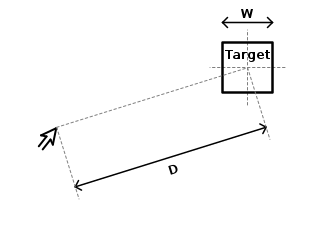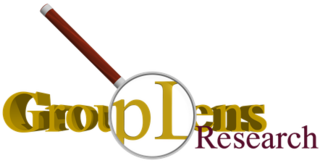Related Research Articles

In computing, a pointing device gesture or mouse gesture is a way of combining pointing device or finger movements and clicks that the software recognizes as a specific computer event and responds to accordingly. They can be useful for people who have difficulties typing on a keyboard. For example, in a web browser, a user can navigate to the previously viewed page by pressing the right pointing device button, moving the pointing device briefly to the left, then releasing the button.

A pointing device is a human interface device that allows a user to input spatial data to a computer. CAD systems and graphical user interfaces (GUI) allow the user to control and provide data to the computer using physical gestures by moving a hand-held mouse or similar device across the surface of the physical desktop and activating switches on the mouse. Movements of the pointing device are echoed on the screen by movements of the pointer and other visual changes. Common gestures are point and click and drag and drop.

Fitts's law is a predictive model of human movement primarily used in human–computer interaction and ergonomics. The law predicts that the time required to rapidly move to a target area is a function of the ratio between the distance to the target and the width of the target. Fitts's law is used to model the act of pointing, either by physically touching an object with a hand or finger, or virtually, by pointing to an object on a computer monitor using a pointing device. It was initially developed by Paul Fitts.
Keystroke logging, often referred to as keylogging or keyboard capturing, is the action of recording (logging) the keys struck on a keyboard, typically covertly, so that a person using the keyboard is unaware that their actions are being monitored. Data can then be retrieved by the person operating the logging program. A keystroke recorder or keylogger can be either software or hardware.
Personal information management (PIM) is the study and implementation of the activities that people perform in order to acquire or create, store, organize, maintain, retrieve, and use informational items such as documents, web pages, and email messages for everyday use to complete tasks and fulfill a person's various roles ; it is information management with intrapersonal scope. Personal knowledge management is by some definitions a subdomain.

In human–computer interaction, WIMP stands for "windows, icons, menus, pointer", denoting a style of interaction using these elements of the user interface. Other expansions are sometimes used, such as substituting "mouse" and "mice" for menus, or "pull-down menu" and "pointing" for pointer.
A recommender system, or a recommendation system, is a subclass of information filtering system that provides suggestions for items that are most pertinent to a particular user. Recommender systems are particularly useful when an individual needs to choose an item from a potentially overwhelming number of items that a service may offer.

In computer displays, filmmaking, television production, and other kinetic displays, scrolling is sliding text, images or video across a monitor or display, vertically or horizontally. "Scrolling," as such, does not change the layout of the text or pictures but moves the user's view across what is apparently a larger image that is not wholly seen. A common television and movie special effect is to scroll credits, while leaving the background stationary. Scrolling may take place completely without user intervention or, on an interactive device, be triggered by touchscreen or a keypress and continue without further intervention until a further user action, or be entirely controlled by input devices.

Banner blindness is a phenomenon in web usability where visitors to a website consciously or unconsciously ignore banner-like information. A broader term covering all forms of advertising is ad blindness, and the mass of banners that people ignore is called banner noise.
GOMS is a specialized human information processor model for human-computer interaction observation that describes a user's cognitive structure on four components. In the book The Psychology of Human Computer Interaction. written in 1983 by Stuart K. Card, Thomas P. Moran and Allen Newell, the authors introduce: "a set of Goals, a set of Operators, a set of Methods for achieving the goals, and a set of Selections rules for choosing among competing methods for goals." GOMS is a widely used method by usability specialists for computer system designers because it produces quantitative and qualitative predictions of how people will use a proposed system.
Exploratory search is a specialization of information exploration which represents the activities carried out by searchers who are:
In computing, post-WIMP comprises work on user interfaces, mostly graphical user interfaces, which attempt to go beyond the paradigm of windows, icons, menus and a pointing device, i.e. WIMP interfaces.
In computing, 3D interaction is a form of human-machine interaction where users are able to move and perform interaction in 3D space. Both human and machine process information where the physical position of elements in the 3D space is relevant.

GroupLens Research is a human–computer interaction research lab in the Department of Computer Science and Engineering at the University of Minnesota, Twin Cities specializing in recommender systems and online communities. GroupLens also works with mobile and ubiquitous technologies, digital libraries, and local geographic information systems.

Human–computer interaction (HCI) is research in the design and the use of computer technology, which focuses on the interfaces between people (users) and computers. HCI researchers observe the ways humans interact with computers and design technologies that allow humans to interact with computers in novel ways. A device that allows interaction between human being and a computer is known as a "Human-computer Interface (HCI)".
Urban computing is an interdisciplinary field which pertains to the study and application of computing technology in urban areas. This involves the application of wireless networks, sensors, computational power, and data to improve the quality of densely populated areas. Urban computing is the technological framework for smart cities.
In web analytics, a session, or visit is a unit of measurement of a user's actions taken within a period of time or with regard to completion of a task. Sessions are also used in operational analytics and provision of user-specific recommendations. There are two primary methods used to define a session: time-oriented approaches based on continuity in user activity and navigation-based approaches based on continuity in a chain of requested pages.
Animal–computer interaction (ACI) is a field of research for the design and use of technology with, for and by animals covering different kinds of animals from wildlife, zoo and domesticated animals in different roles. It emerged from, and was heavily influenced by, the discipline of Human–computer interaction (HCI). As the field expanded, it has become increasingly multi-disciplinary, incorporating techniques and research from disciplines such as artificial intelligence (AI), requirements engineering (RE), and veterinary science.

Shumin Zhai is a Chinese-born American Canadian Human–computer interaction (HCI) research scientist and inventor. He is known for his research specifically on input devices and interaction methods, swipe-gesture-based touchscreen keyboards, eye-tracking interfaces, and models of human performance in human-computer interaction. His studies have contributed to both foundational models and understandings of HCI and practical user interface designs and flagship products. He previously worked at IBM where he invented the ShapeWriter text entry method for smartphones, which is a predecessor to the modern Swype keyboard. Dr. Zhai's publications have won the ACM UIST Lasting Impact Award and the IEEE Computer Society Best Paper Award, among others, and he is most known for his research specifically on input devices and interaction methods, swipe-gesture-based touchscreen keyboards, eye-tracking interfaces, and models of human performance in human-computer interaction. Dr. Zhai is currently a Principal Scientist at Google where he leads and directs research, design, and development of human-device input methods and haptics systems.
Click tracking is when user click behavior or user navigational behavior is collected in order to derive insights and fingerprint users. Click behavior is commonly tracked using server logs which encompass click paths and clicked URLs. This log is often presented in a standard format including information like the hostname, date, and username. However, as technology develops, new software allows for in depth analysis of user click behavior using hypervideo tools. Given that the internet can be considered a risky environment, research strives to understand why users click certain links and not others. Research has also been conducted to explore the user experience of privacy with making user personal identification information individually anonymized and improving how data collection consent forms are written and structured.
References
- ↑ Lopez, Richard B.; Stillman, Paul E.; Heatherton, Todd F.; Freeman, Jonathan B. (2018). "Minding One's Reach (To Eat): The Promise of Computer Mouse-Tracking to Study Self-Regulation of Eating". Frontiers in Nutrition. 5: 43. doi: 10.3389/fnut.2018.00043 . ISSN 2296-861X. PMC 5972293 . PMID 29872661.
- 1 2 Edwards, Benj (1968-12-08). "The computer mouse turns 40". Macworld. Retrieved 2012-02-23.
- ↑ Jacob, Robert J.K.; Karn, Keith S. (2003), "Eye Tracking in Human-Computer Interaction and Usability Research", The Mind's Eye, Elsevier, pp. 573–605, doi:10.1016/b978-044451020-4/50031-1, ISBN 978-0-444-51020-4 , retrieved 2020-11-21
- ↑ Schiessl, Duda, Thoelke, Fischer. "Eye tracking and its application in usability and media research" (PDF). MMI Interaktiv. Retrieved 2013-10-18.
{{cite web}}: CS1 maint: multiple names: authors list (link) - ↑ Byrne, Michael D.; Anderson, John R.; Douglass, Scott; Matessa, Michael (1999). "Eye tracking the visual search of click-down menus". Proceedings of the SIGCHI conference on Human factors in computing systems the CHI is the limit - CHI '99. ACM. p. 402. doi:10.1145/302979.303118. ISBN 0-201-48559-1. S2CID 2212549.
- 1 2 Mueller, Florian; Lockerd, Andrea (2001-03-31). "Cheese". CHI '01 extended abstracts on Human factors in computing systems - CHI '01. ACM. p. 279. doi:10.1145/634067.634233. ISBN 1-58113-340-5. S2CID 6301468.
- ↑ Guo, Qi; Agichtein, Eugene (2010). "Towards predicting web searcher gaze position from mouse movements". Proceedings of the 28th of the international conference extended abstracts on Human factors in computing systems - CHI EA '10. ACM. p. 3601. doi:10.1145/1753846.1754025. ISBN 978-1-60558-930-5. S2CID 16330552.
- ↑ Chen, Mon Chu; Anderson, John R.; Sohn, Myeong Ho (2001-03-31). "What can a mouse cursor tell us more?". CHI '01 extended abstracts on Human factors in computing systems - CHI '01. ACM. p. 281. doi:10.1145/634067.634234. ISBN 1-58113-340-5. S2CID 16969703.
- ↑ Rodden, Kerry; Fu, Xin; Aula, Anne; Spiro, Ian (2008). "Eye-mouse coordination patterns on web search results pages". Proceedings of the twenty-sixth annual CHI conference extended abstracts on Human factors in computing systems – CHI '08. p. 2997. doi:10.1145/1358628.1358797. ISBN 978-1-60558-012-8. S2CID 1759484.
- 1 2 "User See, User Point: Gaze and Cursor Alignment in Web Search" (PDF).
- ↑ "Google nabs patent to monitor your cursor movements". TechEye.net. 20 July 2010. Retrieved 2013-10-18.
- 1 2 "No Clicks, No Problem: Using Cursor Movements to Understand and Improve Search" (PDF).
- 1 2 Arroyo, Ernesto; Selker, Ted; Wei, Willy (2006-04-21). "Usability tool for analysis of web designs using mouse tracks". CHI '06 extended abstracts on Human factors in computing systems - CHI EA '06. ACM. p. 484. doi:10.1145/1125451.1125557. ISBN 1-59593-298-4. S2CID 7684333.
- ↑ Atterer, Wnuk, Schmidt. "Knowing the User's Every Move – User Activity Tracking for Website Usability Evaluation and Implicit Interaction" (PDF). Retrieved 2013-10-18.
{{cite web}}: CS1 maint: multiple names: authors list (link) - ↑ "UsaProxy – Usability Proxy for Websites". Fnuked.de. Retrieved 2012-02-23.
- ↑ Chris Crum (13 July 2010). "Google Eyes Mouse Movement as Possible Search Relevancy Signal". WebProNews. Retrieved 2012-02-23.
- ↑ Guo, Qi; Agichtein, Eugene (2008-07-20). "Exploring mouse movements for inferring query intent". Proceedings of the 31st annual international ACM SIGIR conference on Research and development in information retrieval - SIGIR '08. ACM. p. 707. doi:10.1145/1390334.1390462. ISBN 978-1-60558-164-4. S2CID 2334939.
- ↑ Jorgensen, Zach, and Ting Yu. "On mouse dynamics as a behavioral biometric for authentication." Proceedings of the 6th ACM Symposium on Information, Computer and Communications Security. 2011.
- ↑ Weiss, Adam, et al. "Mouse movements biometric identification: A feasibility study." Proc. Student/Faculty Research Day CSIS, Pace University, White Plains, NY (2007).
- ↑ Agustin, Francis. "Amazon reportedly wants to track its customer service employees by their keyboard strokes and mouse movements". Business Insider. Retrieved 2021-11-22.
- ↑ Pusara, Maja; Brodley, Carla E. (2004-10-29). "User re-authentication via mouse movements". Proceedings of the 2004 ACM workshop on Visualization and data mining for computer security - VizSEC/DMSEC '04. ACM. p. 1. doi:10.1145/1029208.1029210. ISBN 1-58113-974-8. S2CID 1016649.
- ↑ "CHI 97: A Comparison of Reading Paper and On-Line Documents". Sigchi.org. Retrieved 2012-02-23.
- ↑ Cetintas, Luo, Yan, Hord, Dake (2009). "Learning to Identify Students' Off-Task Behavior in Intelligent Tutoring Systems". Proceedings of the 2009 conference on Artificial Intelligence in Education: Building Learning Systems that Care: From Knowledge Representation to Affective Modelling. IOS Press Amsterdam. pp. 701–703. ISBN 978-1-60750-028-5.
{{cite book}}: CS1 maint: multiple names: authors list (link) - ↑ Voßkühler, Adrian; Nordmeier, Volkhard; Kuchinke, Lars; Jacobs, Arthur M. (2008). "OGAMA (Open Gaze and Mouse Analyzer): Open-source software designed to analyze eye and mouse movements in slideshow study designs". Behavior Research Methods. 40 (4): 1150–62. doi: 10.3758/BRM.40.4.1150 . PMID 19001407.